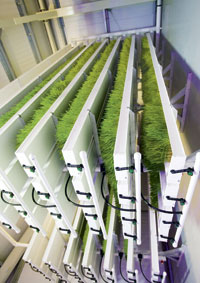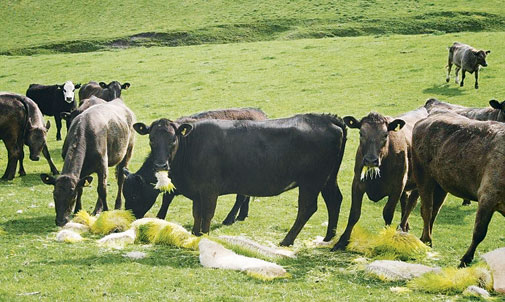A new revolution in grass growing

Grass grown indoors without soil at a rate of seed-to-feed in seven days. It may sound crazy, but it could be the saving grace for UK farmers. Sarah Trickett reports
The weather and its effects on forage production are probably one of the most talked-about problems in agriculture in recent years, with 2010 no exception. It’s either too hot, cold, dry or wet, which creates a headache when feeding large volumes of forage.
But that headache could be over for farmers in the way of hydroponic fodder production – essentially growing fodder indoors in water. Although it is not a new technology, a new system is making it more accessible to farmers, explains H20 Farm director Howard Campion.
“We have developed a system that grows sprouting barley fodder (essentially young spring grass grown from a cereal grain) from seed-to-feed in seven days, all year, and independent of weather conditions,” Mr Campion says.
The system grows barley using nutrient film technique so plant roots are grown in trays in a thin film of water and nutrients, keeping them moist but not waterlogged.
H2O Farm specialises in hydroponic fodder production and recently opened a fully operational facility at the Spanish Bit Equestrian Centre, Windsor, producing sprouting fodder for 45 horses. The facility can produce more than 1t of fresh-sprouting fodder every day, which has been critical given the lack of fodder in the area, explains farm manager Keith Harris.
“Because of this year’s dry conditions we only have a third of the hay we would usually have, so we are short on fodder. We have been saved by the system and have also reduced feed costs by about 60% after replacing two daily feeds with fresh-sprouting fodder. The horses are also in better condition and have a shine to their coat.”
Mr Harris first saw the technology in Australia last year and decided to install it at his riding school following the shortage and inconsistency of forage in recent years. “We visited an Australian farmer in the outback with 2000 sheep and, because of extreme weather conditions, the only way he could survive was by producing fodder this way. He believed that without the system he would have lost more than 1000 sheep because of a lack of feed. This was when I decided to invest in the system.”

Now the 10m-wide x 13m-long building, installed earlier this year, is producing up to 9kg/sq m of fresh-sprouting fodder (1.2t) a day, which is enough to feed about 120 cattle, more than 1500 sheep and 500 pigs. “The annual production in fresh-sprouting fodder is the equivalent to the output from 298 acres of grassland, all in a space that measures just 130sq m,” says Mr Campion.
And it is not expensive to grow at just 6p/kg. “People may think growing fodder indoors would require a lot of water and electricity. But less than 700 litres of water is required for every tonne of forage with any unused water re-circulated during the growing process. The sprouting fodder requires no light source, which means only 60kW of electricity is used a day for the air-conditioning and pump.”
But the benefits go further than the saving in feed costs and the guaranteed supply of fresh fodder all year, says Mr Harris. “The main benefit for me and any livestock farmer is the consistency in the product produced. A change in diet can disrupt the digestive system, but this keeps it stable. Both horses and people are also exposed to less dust from the hay, which has reduced respiratory problems.”
And although sprouting barley is not designed to replace all dry matter, it is suggested to feed livestock at a rate of 3-3.5% of body weight, says Mr Campion. “Sprouting fodder can also be mixed in to a TMR. And although it has a low dry matter content, it still acts as a good finishing diet. A study on beef cattle found bulls fed rape and hay plus a fodder supplement at 3.75kg/day compared to those fed a diet of rape and hay alone had a live weight gain 41% higher.
Trials have also shown feeding sprouting fodder to dairy cows also increases yield and butterfat, says Mr Campion.
| Hydroponic Fodder production • Reduces feed costs • Frees up land • Consistent fodder quality • Aids digestion • Better performance • Low cost of production • Overall cost about £150,000 |
|---|
And because sprouting barley is packed with minerals and enzymes that improve absorption, it helps the digestion of other feed and puts less stress on the digestive system, adds Mr Campion. “It has 23 times more vitamin A than carrots, 22 times more vitamin B than lettuce and 14 times more vitamin C than citrus fruits.”
The system is no more labour-intensive either, says Mr Harris. It requires about three hours a day management. The fodder can be pulled from the tray and fed in strips or, like we do, chopped in to biscuits and fed to horses that way. The trays that are harvested then need to be cleaned and the cycle started again with fresh barley seed. This means we have seven growing stages in the building, which guarantees a constant fresh supply of fodder.”
The fact such a large amount of feed can be grown in just 130sq m makes this system ideal for those who are land-locked, adds Mr Harris. “Some people may wish to increase herd size but if they are land locked this is hard, making this the ideal solution. It may also free up land that was previously used to produce fodder for other means.”
And the costs that could be gained by freeing up land for other revenue-generating purposes could set the initial cost of about £150,000 in a better light, says Mr Campion. “It is a big investment, but farmers know they will have feed for their animals every day of the year regardless of the weather and market prices. This cost includes everything, from building to three months of grain and six months of nutrients to feed the grain as well as support with financial packages also available to spread costs.”
DAIRY EVENT 2010
For more information on hydroponic fodder production visit the Dairy Event and Livestock Show at the NEC, Birmingham on 7 and 8 September. For more information and to view a list of exhibitors, go to www.fwi.co.uk/dels2010

